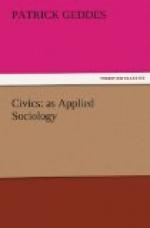[12] Without forgetting the many institutions and workers in almost all departments of the field of civics, the rise of definite surveys and of scientific groupings like this Society, without ignoring also the many admirable workers and institutions of social endeavour, and their progressive integration into Social Unions, Institutes of Service, and the like, I may be permitted to press for the need of uniting both types, the scientific and the practical, into a single one—a civic museum and active centre in one. Of this type, my own Outlook Tower at Edinburgh is, so far as I am aware, the earliest beginning; and, despite its rudimentary condition, may thus serve to suggest a type of institution which will be found of service alike to the sociologist and the citizen.
M—THE HISTORIC CITY-COMPLEX
The criticism may have already arisen in the reader’s mind that the “Town” and “School” of our analysis are by no means so simple as we have assumed them. Our surveys of antique towns ever disclose the material survivals, at least the vestiges, of the cloister or the acropolis of the past, of its cathedral or its forum. The processes of our industries, in what is now their daily artisan routine, include, repeat, condense, what were yesterday or longer ago living inventions, each instinct with Promethean fire. The hackneyed ornament of our homes was once glowing with beauty, radiant or dark with symbolism. So it is for our everyday customs and institutions, and so for living languages; our own, perhaps, most of all. These, of course, are facts made familiar by investigators of all orders, from the scholar and antiquary of old, the historian and philologist of yesterday, to the geographer or the sociologist of our own time: witness Mr. Spencer’s masterly treatment of their main results. How, then, shall we correlate this process of all things growing old with the analysis of cities above attempted? In other words, how shall we interpret the course of their historic evolution, their renewed growth and decay, progress and degeneracy, their present condition, crowded with residues of the past, with those potentialities which our outline discloses? This is the more necessary since this fourfold analysis applies in principle to all human groupings from the simplest village to the Eternal City. To this, indeed, we have in principle already traced it, onwards from our primitive valley section with its humble hamlets, its fundamental occupations. Returning then to our main diagram, with its four-fold analysis of the City so soon as we have completed this, and [Page: 94] carried its progress up to the level of city life proper, we must next turn over the leaf and begin a new page, with place and work and folk once more. This simplest of acts expresses with graphic significance the very process of history; for in closing our diagram page its “Cloister” has been folded down on the “School,” our cathedral and forum,




